

Creating a realtime Tweet visualization in 3-D. The volume of Tweets available through Twitter’s streaming APIs is quite impressive.

While these public streaming APIs provide a smaller subset of all Tweets by definition, the amount of real-time data they return can still be a bit overwhelming to process and visualize. Thankfully, WebSockets is a great solution for sending large volumes of Tweets; when paired with WebGL, it allows for creative ways to visualize Twitter data. Santi8ago8/twitterExplorer. Tweet emotion: real-time Tweet analysis with PubNub Data Stream. PubNub recently released a demo Twitter stream published through their hosted websockets.
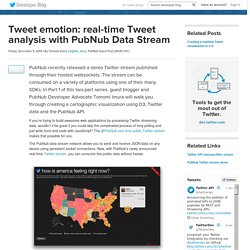
The stream can be consumed on a variety of platforms using one of their many SDKs. In Part 1 of this two-part series, guest blogger and PubNub Developer Advocate Tomomi Imura will walk you through creating a cartographic visualization using D3, Twitter data and the PubNub API. If you’re trying to build awesome web applications by processing Twitter streaming data, wouldn’t it be great if you could skip the complicated process of long polling and just write front-end code with JavaScript? Datavisualization with Angular and d3 on the Twitter Stream API. It’s been a few months since I wanted to make a data visualization project based on Angular and d3.

The one thing that was missing was some data to work with … I tried to find something that fit me on open-data sites but I was unsuccessful. I finally had the idea to use the Twitter Stream API, which would get me lots of data to process and moreover, in realtime … Making Angular.js Real-Time with Pusher - Pusher. UPDATE: We released an official Angular.js library since that blog post.
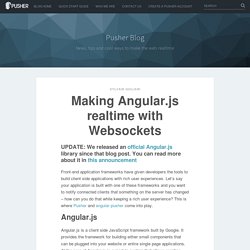
You can read more about it in this announcement Front-end application frameworks have given developers the tools to build client side applications with rich user experiences. Let’s say your application is built with one of these frameworks and you want to notify connected clients that something on the server has changed – how can you do that while keeping a rich user experience? This is where Pusher and angular-pusher come into play. Angular.js Angular.js is a client side JavaScript framework built by Google. All of these are used within controllers to create, retrieve, update, and delete data while providing nice features for manipulating the HTML DOM with little custom JavaScript code.
In a simple Angular.js application, data is retrieved and sent to and from a backend server through an $http or $resource service provided by the framework. Writing real time applications using Spring, AngularJS and WebSockets - g00glen00b. HTML5 made browsers a powerful alternative to desktop applications.

However, network traffic (when using AJAX or by simply loading pages) is always in one direction. The client requests a page from the server, which in turn responds with the proper content. With HTML5 WebSockets that’s a different story, websockets allow you to setup a full duplex channel between server and client, making it possible to send messages in both ways. Getting started with MEAN stack. Here it is a quick guide to start developing in nodejs using a typical MEAN stack using express framework, a non-relational database such as mongodb, and of course angularjs.

I won’t explain what those technologies are (if you don’t know what I’m talking about you can search for topics such as mongodb, expressjs, nodejs, angularjs), I will just explain how to getting started and how to setup a typical MEAN stack. Of course I assume you already have nodejs and expressjs installed on your enviroment. > Download it from here > Unzip it into your folder (ex. "myfolder\mongodb")> Navigate into directory: "myfolder\mongodb\bin"> Open prompt here and run the following command: "mongod --dbpath data"> Install mongoose opening a new prompt and typing: "npm install mongoose" Let’s now create a simple node.js server.
> Create a new server as shown up > Navigate into directory: "myfolder\myapp"> Type: "node server.js" (this will start the server) Using Node.js and Socket.IO to Stream Tweets From the Twitter API. Wednesday, June 20, 2012 I've discussed in a previous blog post about the Twitter API.
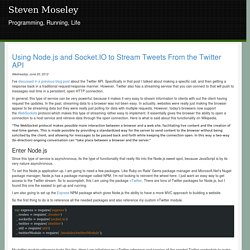
Specifically in that post I talked about making a specific call, and then getting a response back in a traditional request/response manner. However, Twitter also has a streaming service that you can connect to that will push to messages real time in a persistent, open HTTP connection. In general, this type of service can be very powerful, because it makes it very easy to stream information to clients with out the client having request the updates.
In the past, streaming data to a browser was not been easy. "The WebSocket protocol makes possible more interaction between a browser and a web site, facilitating live content and the creation of real-time games. Enter Node.js Since this type of service is asynchronous, its the type of functionality that really fits into the Node.js sweet spot, because JavaScript is by its very nature asynchronous. var express = require('express') , routes = require('. Origin: Adding Real-Time To A RESTful Rails App - Liam Kaufman. After rewriting Understoodit several times I’ve spent a lot of time thinking about building real-time web applications.
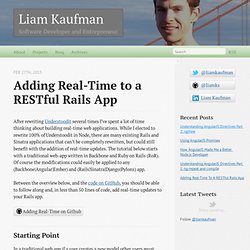
While I elected to rewrite 100% of Understoodit in Node, there are many existing Rails and Sinatra applications that can’t be completely rewritten, but could still benefit with the addition of real-time updates. The tutorial below starts with a traditional web-app written in Backbone and Ruby on Rails (RoR). Of course the modifications could easily be applied to any (Backbone|Angular|Ember) and (Rails|Sinatra|Django|Pylons) app. Between the overview below, and the code on GitHub, you should be able to follow along and, in less than 50 lines of code, add real-time updates to your Rails app. Getting Real-Time with Pusher. Do you want to spice up your web applications by making them real-time — but don't want to create new infrastructures for the sole purpose of getting web sockets to work?
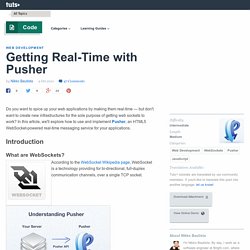
In this article, we'll explore how to use and implement Pusher, an HTML5 WebSocket-powered real-time messaging service for your applications. According to the WebSocket Wikipedia page, WebSocket is a technology providing for bi-directional, full-duplex communication channels, over a single TCP socket.